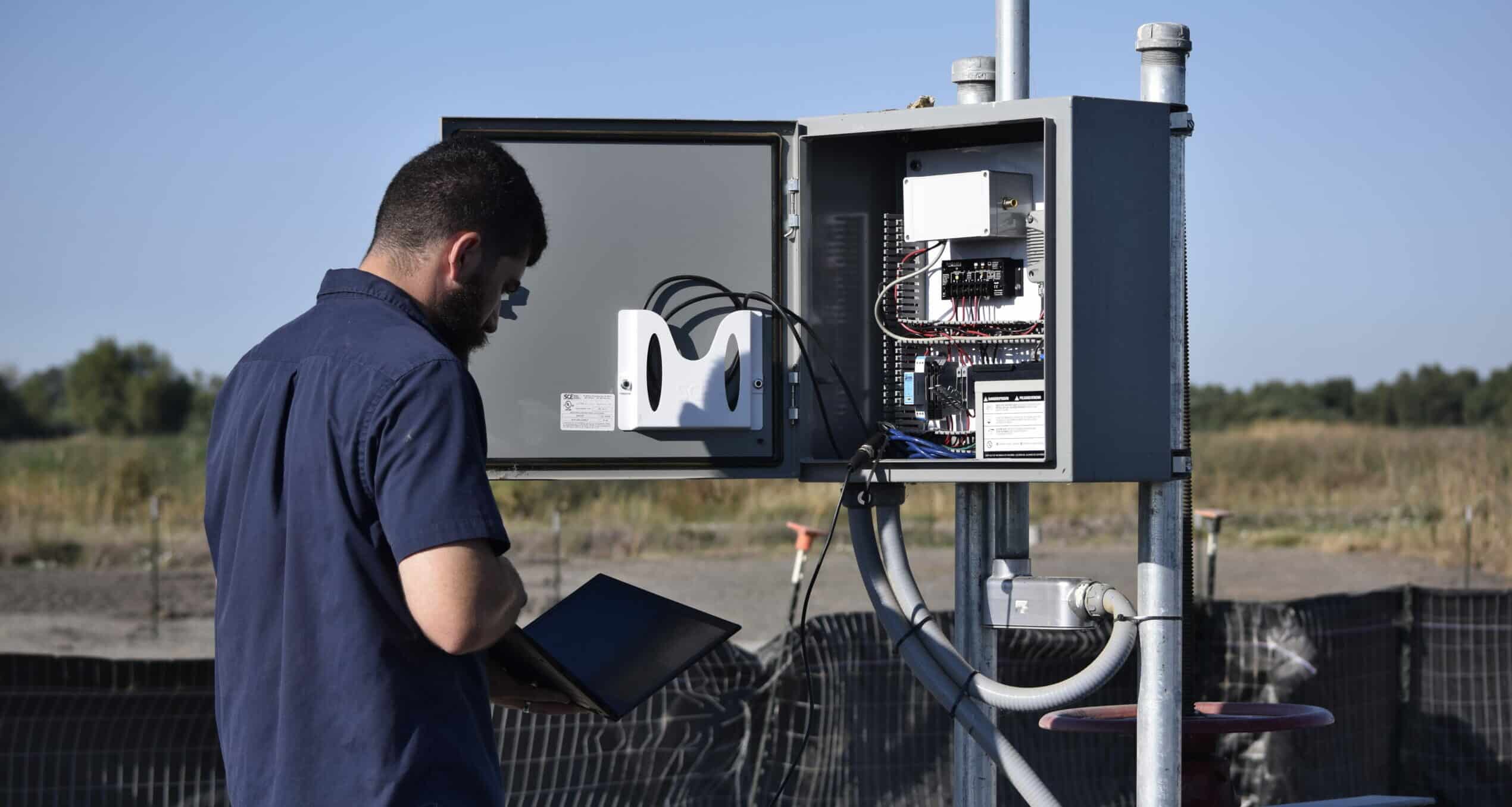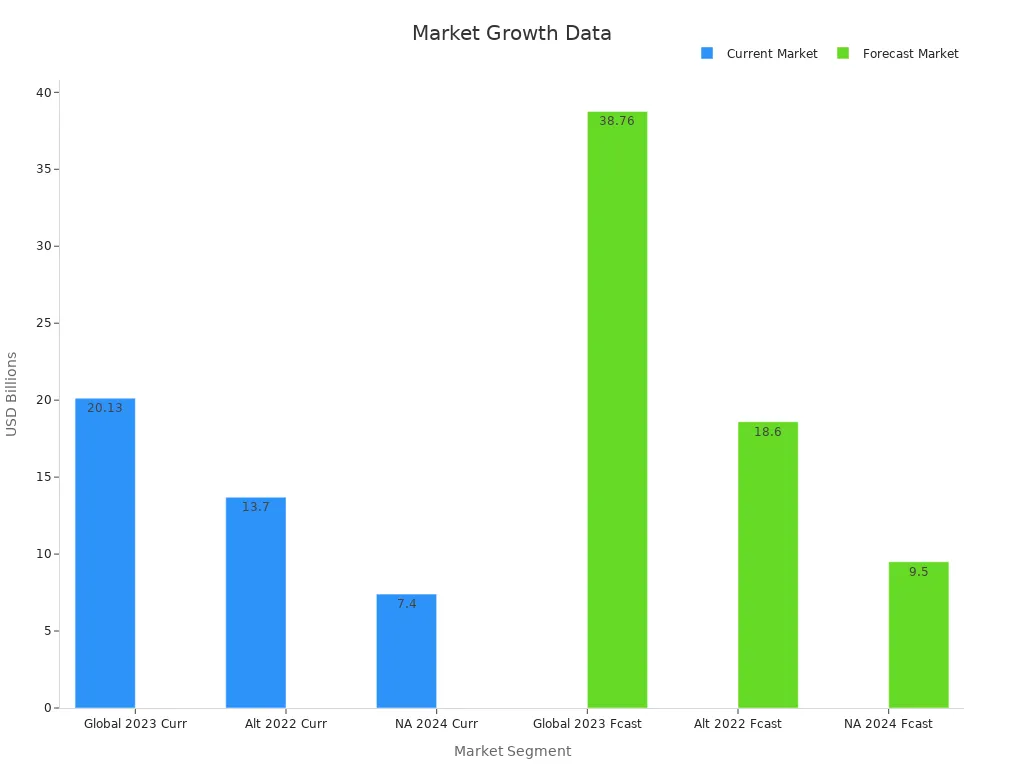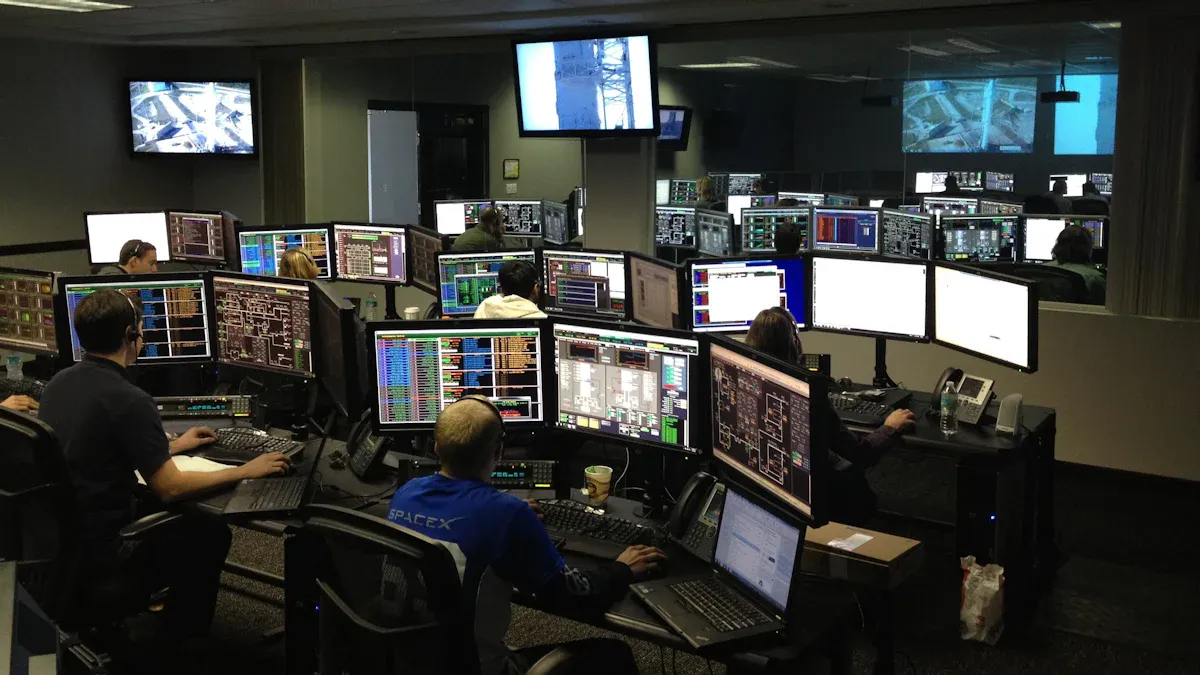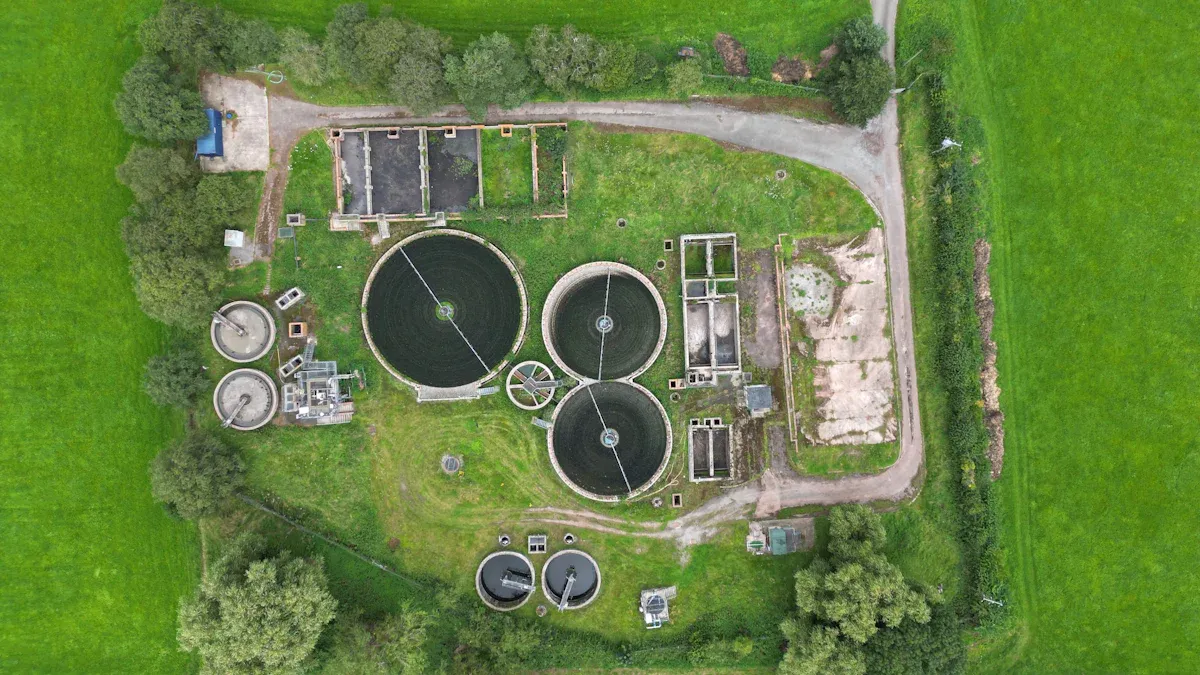What is an Environment Monitoring System and How Does ESTEL Make It Work

An environment monitoring system gives you real-time insight into the conditions of your surroundings. You use sensors to track key environment factors like temperature, humidity, and air quality. These systems gather data, then advanced technologies such as AI and machine learning process the information. This approach helps you spot trends, detect risks, and protect the ecosystem. The global market for environmental monitoring is growing rapidly, as shown in the table below.
Metric | Value (Year) | Forecast Period | Forecast Value / CAGR |
|---|---|---|---|
Global Market Size | USD 20.13 billion (2023) | 2024-2030 | CAGR 9.81%, USD 38.76 billion (2030) |
North America Market Size | USD 7.4 billion (2024) | 2024-2029 | CAGR 5.1%, USD 9.5 billion (2029) |

Key Takeaways
Environmental monitoring systems use sensors to watch things like temperature, humidity, and air quality.
They show you changes right away, so you can find problems early and keep your space safe.
The system follows steps, from putting sensors in place to checking data and sending alerts.
This helps you watch things closely and act fast if something changes.
These systems help save money and keep people safe.
They also help you follow rules by giving reports and warnings about problems.
ESTEL’s system gives alarms right away and lets you set your own alerts.
It has strong tools to look at data, so you can control places like computer rooms and factories.
Using ESTEL’s solutions helps you make good choices and lower risks.
You can keep your workspace safe and healthy, and get help from experts when you need it.
How an Environment Monitoring System Works

Core Functionality of Environmental Monitoring
You rely on an environmental monitoring system to keep track of your surroundings and maintain safe, efficient operations. The core functionality centers on collecting accurate data about environmental conditions. Specialized sensors measure parameters such as air quality, temperature, humidity, gas concentrations, pressure, and pH levels. You place these sensors strategically to ensure you capture representative data from all critical zones and potential hazard areas.
Once the sensors collect data, the environmental monitoring system transmits this information to advanced software platforms. These platforms give you real-time visualization through customizable dashboards. You can see trends, spot deviations, and receive alerts when environmental conditions move outside safe limits. This real-time monitoring helps you take immediate action to prevent problems before they escalate.
Note: Continuous monitoring supports early risk detection, pollution prevention, and operational optimization. You also meet regulatory requirements more easily because the system automates reporting and documentation.
Environmental monitoring systems transform raw data into actionable insights. You can identify trends, predict risks, and make informed decisions. For example, organizations use these systems to comply with regulations like the US Clean Water Act. By tracking environmental impacts proactively, you avoid disruptions, reduce liability, and manage risks more effectively. This approach improves your operational efficiency and helps you maintain a safe environment.
In industrial settings, integrating real-time monitoring with predictive analytics leads to significant improvements. At a limestone quarry in Ethiopia, the use of IoT-based environmental monitoring and machine learning reduced airborne dust by nearly 50%, cut NO2 emissions by 25%, and lowered noise levels by up to 17%. Predictive models achieved high accuracy, enabling proactive interventions before pollution spikes. These results show how environmental monitoring systems can optimize resource allocation, enhance compliance, and support ecological restoration.
Typical Workflow in Environmental Monitoring Systems
You follow a structured workflow when you use an environment monitoring system. This process ensures you collect, analyze, and act on environmental data efficiently.
Planning and Sensor Placement
You start by identifying the key environmental parameters you need to monitor. You select the right sensors and place them in strategic locations to capture accurate data.Data Collection
The sensors continuously gather real-time data on factors like temperature, humidity, air quality, and gas concentrations. This step forms the foundation of your monitoring functions.Data Transmission and Storage
The system transmits collected data to a central platform, often using wireless networks. You store this data securely for analysis and reporting.Real-Time Monitoring and Visualization
You access dashboards that display real-time monitoring results. These dashboards help you track trends, spot anomalies, and maintain control over your environment.Analysis and Alerts
Advanced analytics tools process the data, using methods like Statistical Process Control (SPC) to monitor process variation. You receive automated alerts when the system detects deviations from normal conditions. This allows you to take corrective action quickly.Reporting and Compliance
The system generates automated reports for regulatory compliance. You can customize these reports to meet specific requirements, making it easier to demonstrate adherence to environmental standards.Continuous Improvement
You use methodologies like DMAIC (Define, Measure, Analyze, Improve, Control) and PFMEA (Process Failure Mode and Effects Analysis) to identify risks and improve processes. The system supports trend analysis, deviation tracking, and integration with quality management systems for ongoing optimization.
You benefit from features such as automated scheduling, sampling management, and deviation management. These features reduce human error, ensure timely testing, and help you maintain high data accuracy.
Pro Tip: Integrating additional sensors, such as wind direction monitors, can enhance your safety protocols and decision-making.
Environmental monitoring systems give you the tools to maintain control, respond to risks, and optimize your operations. By following a structured workflow, you turn environmental data into actionable insights that protect your assets and the environment.
Why Environmental Monitoring Matters
Key Benefits of Environmental Monitoring
You gain many advantages when you use environmental monitoring in your operations. Monitoring helps you maintain a safe working environment and protect your ecosystem from contamination. You can track air quality, water quality, and other key factors in real time. This approach supports early detection of environmental risks, which allows you to act before problems escalate.
AI-driven environmental monitoring improves pollution detection and enables real-time interventions. You can forecast air quality and manage risks more effectively. By integrating diverse data sources, you get a complete view of your ecosystem and can respond quickly to contamination.
You also benefit from financial savings. Many businesses report lower environmental costs, direct savings through source reduction, and cost avoidance. You improve your reputation with regulators and customers by showing your commitment to a safe working environment. Monitoring supports compliance, helps you avoid legal penalties, and fosters a culture of sustainability.
A recent study in Nature Communications confirms that environmental monitoring, especially when combined with IoT, leads to better operational safety and efficiency. The study found a strong link between monitoring and improved equipment management, predictive analytics, and safety monitoring. You can use these insights to enhance your management systems, train employees, and ensure corrective actions are taken when needed.
Common Use Cases for Environmental Monitoring Systems
You find environmental monitoring in many industries and settings. In agriculture, you use monitoring to track soil moisture and water quality, which supports precision farming and protects the ecosystem. In manufacturing, you rely on pollution monitoring systems to control emissions and prevent contamination. Industrial environmental monitoring helps you meet strict regulations and avoid fines.
Energy companies use monitoring to track renewable energy factors and manage environmental impacts. Urban planners use air quality monitoring and noise sensors to create healthier cities. In mining, you use vibration and contamination monitoring to protect historic sites and comply with legal standards.
Marine and coastal environments also benefit from monitoring. For example, sensor-equipped buoys provide real-time data on water quality and pollution detection. This information helps you assess the impact of operations and protect sensitive ecosystems.
You can see how monitoring supports water quality monitoring, air quality monitoring, and contamination monitoring across different sectors. These systems help you maintain a safe working environment, reduce risks, and ensure the long-term health of your ecosystem.
Components and Technologies in Environmental Monitoring Systems

Sensors and Data Collection Methods
You rely on advanced sensors to collect accurate data for environmental monitoring. These sensors measure temperature and humidity, air quality, water quality, and even toxic gas levels. You can use compact, unobtrusive sensors for continuous real-time monitoring in many environments. For example, IoT sensors detect contaminants, oxygen, and pH in water systems, while others track pollutants like carbon monoxide and particulates in the air. You can also monitor temperature and humidity in sensitive areas, such as server rooms or laboratories, to prevent contamination and equipment failure.
To ensure reliable monitoring, you should select the right environmental indicators and follow standardized protocols. You can use multi-sensor fusion to combine data from different sensors, which improves accuracy and reduces uncertainty. This approach helps you control the environment and respond quickly to changes. You also benefit from customizable solutions that adapt to your specific needs and integrate with other systems for comprehensive monitoring.
Note: Calibration and proper sensor placement are essential for accurate temperature and humidity readings. Regular testing and maintenance help you maintain high data quality.
Data Transmission and Storage in Environmental Monitoring
Once you collect data, you need to transmit it securely and store it for analysis. You can use wireless networks to send real-time data from sensors to a central platform. This process supports continuous monitoring and immediate control over environmental conditions. You store the data in secure databases, which allows you to track trends and generate reports.
You should establish clear goals for your monitoring system, including the spatial and temporal scope of data collection. By following robust frameworks and quality assurance procedures, you guarantee reliable data storage and transmission. Low-cost monitoring systems can help you expand coverage, but you must address technical barriers and ensure compatibility with traditional technologies to maintain accuracy.
Data Analysis, Reporting, and Alerts
You use advanced analytics to turn raw data into actionable insights. Statistical techniques like regression analysis, anomaly detection, and time-series analysis help you identify patterns and root causes of environmental changes. You can visualize data through dashboards and charts, making complex information easy to understand.
The alarm function is a critical feature in environmental monitoring. You receive automated alarms when temperature and humidity exceed safe limits or when contamination is detected. These alarms allow you to take immediate control and prevent damage. The alarm function supports compliance by generating reports and alerting you to deviations from standards. You can customize the alarm function to match your operational needs, ensuring you never miss a critical event.
Pro Tip: Use prescriptive analytics and machine learning to enhance your alarm function. These tools recommend actions and validate alarm processes, helping you maintain a safe environment.
You build a data-driven culture by making data accessible and training your team to respond to alarms. Continuous improvement of your analytics and alarm function ensures your environmental monitoring system remains effective and reliable.
ESTEL’s Environmental Monitoring System Solutions
How ESTEL’s System Operates
You can rely on ESTEL’s environmental monitoring system to deliver precise and timely information about your environment. The system operates on a robust DEC VAX 11/785 computer, which connects to other platforms for seamless data retrieval. You benefit from the integration of ARC/INFO GIS software, which allows you to analyze spatial data and combine it with tabular environmental information. This setup helps you visualize trends and make informed decisions.
When you use ESTEL’s system, you access a wide range of statistical and mathematical tools. These include time series analysis, regression, cluster analysis, and forecasting. You can process large volumes of data efficiently, thanks to advanced libraries like IMSL and BMDP. These libraries support complex operations such as econometrics and experimental design. You also have access to digital map libraries that cover political boundaries, land use, elevation, hydrography, and infrastructure. This comprehensive approach ensures you can monitor and control your environment with confidence.
You receive support throughout your monitoring process. ESTEL provides operational procedures for preparing your data for GIS analysis. You can consult with experts for customized data processing and prestudy spatial analyses. This support helps you set up your monitoring system correctly and ensures you get the most accurate results.
Tip: You can combine data from multiple sources, such as the NCC IBM system and GIS in Las Vegas, to enhance your environmental monitoring capabilities.
Unique Features of ESTEL’s Environmental Monitoring System
You will notice several unique features when you use ESTEL’s environmental monitoring system. The system offers advanced alarm functions that keep you informed about any changes in your environment. You receive real-time alarms when temperature, humidity, or other parameters exceed safe limits. These alarms help you take immediate control and prevent damage or contamination.
ESTEL’s system supports a broad range of monitoring applications. You can use it for air quality, water quality, and even specialized environments like computer rooms. The alarm function is highly customizable. You can set thresholds for different parameters and receive alerts through multiple channels, such as SMS, email, or on-screen notifications. This flexibility ensures you never miss a critical event.
You also benefit from the system’s ability to integrate statistical and spatial analyses. You can perform time series analysis, regression, and cluster analysis directly within the platform. The system’s digital map libraries allow you to visualize environmental data on detailed maps. This feature helps you identify patterns and respond quickly to potential risks.
Key features include:
Real-time monitoring and alarm notifications
Integration with GIS for spatial analysis
Support for multiple data sources and formats
Customizable alarm thresholds and notification methods
Access to expert consultation and prestudy support
Note: The alarm function is essential for maintaining control in sensitive environments, such as computer rooms, where even minor changes in temperature or humidity can cause equipment failure.
Real-World Applications, Including Computer Room Environmental Monitoring System
You can apply ESTEL’s environmental monitoring system in many real-world scenarios. One of the most important applications is the computer room environmental monitoring system. In these settings, you need to maintain strict control over temperature, humidity, and air quality to protect sensitive equipment. The system’s alarm function alerts you immediately if any parameter moves outside the safe range. This rapid response helps you prevent costly downtime and equipment damage.
You can use the computer room environmental monitoring system to track multiple parameters at once. The system collects data from sensors placed throughout the room. You receive real-time updates and alarms on your dashboard. If the temperature rises or humidity drops, the alarm notifies you so you can take action right away.
Other applications include industrial plants, laboratories, and data centers. In each case, the alarm function plays a critical role. You can set specific thresholds for each environment and customize the alarm notifications to suit your needs. The system’s ability to integrate with GIS and other data sources makes it a powerful tool for comprehensive environmental monitoring.
Application Area | Key Parameters Monitored | Alarm Function Role |
|---|---|---|
Computer Rooms | Temperature, Humidity | Immediate alerts for deviations |
Data Centers | Air Quality, Power | Prevents equipment failure |
Laboratories | Contamination, pH | Ensures safe working conditions |
Industrial Plants | Gas, Noise, Vibration | Supports compliance and safety |
Pro Tip: Regularly review your alarm settings in the computer room environmental monitoring system to ensure optimal protection for your equipment.
You can trust ESTEL’s environmental monitoring system to deliver reliable monitoring, rapid alarm notifications, and effective control in any environment. The system’s flexibility and advanced features make it an ideal choice for protecting your assets and maintaining a safe, compliant workspace.
You gain real advantages when you use environmental monitoring systems. These tools help you protect your environment, reduce risks, and support a healthy ecosystem. ESTEL’s solutions give you reliable monitoring and fast alerts, so you can act quickly. You see clear data and make smart decisions. If you want to keep your environment safe and meet your goals, consider ESTEL for your monitoring needs.
FAQ
What is the main purpose of an environmental monitoring system?
You use an environmental monitoring system to track conditions like temperature, humidity, and air quality. This system helps you detect risks early, protect your assets, and ensure a safe environment.
Tip: Regular monitoring supports compliance with safety and environmental regulations.
How does ESTEL’s alarm function help you?
ESTEL’s alarm function notifies you instantly when conditions move outside safe limits. You receive alerts by SMS, email, or on-screen notifications.
Immediate action prevents equipment damage
Fast response reduces downtime
Can you customize ESTEL’s monitoring system for different environments?
Yes, you can tailor ESTEL’s system for various settings, such as computer rooms, laboratories, or industrial plants. You set specific thresholds and choose notification methods that fit your needs.
What types of data can you monitor with ESTEL’s system?
You can monitor a wide range of data, including:
Temperature
Humidity
Air quality
Gas levels
Noise and vibration
This flexibility lets you protect many types of environments.
Is it difficult to install and use ESTEL’s environmental monitoring system?
You find ESTEL’s system user-friendly. The setup process is straightforward, and you receive expert support.
Note: Clear instructions and customizable dashboards make daily use simple for you.
See Also
Understanding How Supervision Systems Integrate With ESTEL Cabinets
An Overview Of Power Systems In ESTEL Telecom Cabinets
Exploring ESTEL PDUs And Their Function Within Data Cabinets
Key Safety Features Of Custom ESTEL Outdoor Telecom Cabinets
Benefits Of ESTEL Cooling Solutions For Industrial Cabinet Use
CALL US DIRECTLY
86-13752765943
3A-8, SHUIWAN 1979 SQUARE (PHASE II), NO.111, TAIZI ROAD,SHUIWAN COMMUNITY, ZHAOSHANG STREET, NANSHAN DISTRICT, SHENZHEN, GUANGDONG, CHINA

